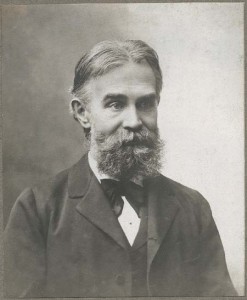 Born March 13, 1840
Born March 13, 1840
Birthplace Boston, MA
Died December 15, 1923
Grave Site Cremated at Mt. Hope Cemetary, Rochester, NY
Contribution A leader in regional and national suffrage organizations.
William Channing Gannett, Unitarian clergyman and social reformer, was born on March 13, 1840 in Boston, Massachusetts. His father was the Reverend Ezra Stiles Gannett, colleague and successor to William Ellery Channing, a famous American Unitarian minister, anti-slavery advocate and essayist. Gannett’s mother was Anna Tilden Gannett.
Gannett was educated at Harvard, where he received his Bachelor of Arts degree in 1860 and his Masters of Arts degree in 1863. During the 1860s, he also spent three years working with freed African Americans in Port Royal, South Carolina. From 1865 to 1866, he toured Europe. He then returned to Harvard. In 1868 he graduated from its Divinity School and became a Unitarian minister.
From his earliest years in the ministry, Gannett adopted the mantle of reform. While pastor of the Unitarian church in Milwaukee, Wisconsin (1868-1870), he actively participated in Milwaukee’s woman suffrage convention in 1869, and was vice president of the state’s woman’s suffrage association. During this time he also became acquainted with Susan B. Anthony, Elizabeth Cady Stanton, and Mary Livermore.
Gannett ministered in East Lexington, Massachusetts from 1871 to 1872. There, he was instrumental in establishing a “Country Week” — a means through which poor children, their mothers and working girls might vacation for one week during the summer. When he moved to the Unitarian Church in St. Paul, Minnesota (1877-1883), he formed a “Unity Club,” which included a glee club, an art class, and reading and discussion groups.
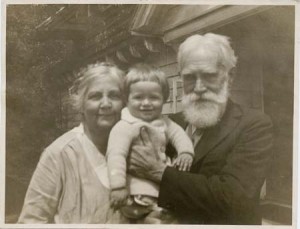 In September of 1887, Gannett assumed the pastorate of the Unitarian society in Hinsdale, Illinois. That same year, on November 3, he married Mary Thorn Lewis, a Philadelphia Quaker whom he had met some twelve years earlier. While Mary Gannett was to become an active partner with her husband in the Unitarian Church, she never gave up her membership in the Society of Friends. The Gannetts had two children. One, Lewis Stiles Gannett, was to become a literary critic for the New York Herald Tribune.
In September of 1887, Gannett assumed the pastorate of the Unitarian society in Hinsdale, Illinois. That same year, on November 3, he married Mary Thorn Lewis, a Philadelphia Quaker whom he had met some twelve years earlier. While Mary Gannett was to become an active partner with her husband in the Unitarian Church, she never gave up her membership in the Society of Friends. The Gannetts had two children. One, Lewis Stiles Gannett, was to become a literary critic for the New York Herald Tribune.
The Gannetts moved to Rochester, New York as pastor and wife of the Unitarian Church in the spring of 1889. In Rochester, they became known as a formidable team in the city’s reform movements of the late nineteenth and early twentieth centuries. They were so much of a team it is often hard to separate the accomplishments of the two. Much of the work done by the Unitarian Church in Rochester during Gannett’s pastorate must therefore be seen as the work of both.
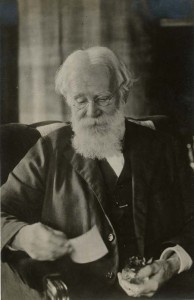 Soon after they moved, Gannett proposed the establishment of a place where boys of all faiths could come during the evenings to take classes, learn arts and crafts, and socialize in a safe environment. An organizational meeting for the Boys Evening Home (BEH) was held in December of 1889. The BEH opened on January 7, 1890 and became an immediate success.Photograph of William Gannett By 1893, it was expanded to include a paid superintendent, a new workshop, classes in manual arts, drawing and clay modeling, and a Sunday evening reading room. At the end of the 1890s, the Boys Evening Home provided a wide range of classes, including spelling, penmanship, history, zoology, physiology, geography, literature, natural history, and journalism. By the first decade of the twentieth century, roughly two hundred boys participated in BEH twice weekly, and some of its members had established their own newspaper, Boys Evening Home Journal. In 1910, when the facilities were once again expanded, the parish house was renamed Gannett House in honor of the BEH founder.
Soon after they moved, Gannett proposed the establishment of a place where boys of all faiths could come during the evenings to take classes, learn arts and crafts, and socialize in a safe environment. An organizational meeting for the Boys Evening Home (BEH) was held in December of 1889. The BEH opened on January 7, 1890 and became an immediate success.Photograph of William Gannett By 1893, it was expanded to include a paid superintendent, a new workshop, classes in manual arts, drawing and clay modeling, and a Sunday evening reading room. At the end of the 1890s, the Boys Evening Home provided a wide range of classes, including spelling, penmanship, history, zoology, physiology, geography, literature, natural history, and journalism. By the first decade of the twentieth century, roughly two hundred boys participated in BEH twice weekly, and some of its members had established their own newspaper, Boys Evening Home Journal. In 1910, when the facilities were once again expanded, the parish house was renamed Gannett House in honor of the BEH founder.
During the Gannetts’ tenure, the Unitarian Church also formed a Unity Club, which included reading and study groups. Some of these groups studied literature, poetry, and the arts, while others discussed contemporary social and political topics such as school reform, the labor movement and women’s rights.
Gannett maintained his interest in regional and national associations while he was pastor of Rochester’s Unitarian Church. He participated in the Free Religious Association, the New York State Parliament of Religion, Middle States and Canada Conference (Rochester was the host city for its 1896 meeting), and the Unitarian Temperance Society. He also worked closely with other liberal clergy in Rochester to encourage ecumenicism (the promotion of unity among churches), especially in matters of charity. In 1895 and again in 1901 he was involved in unsuccessful attempts to establish vehicles for organized interfaith cooperation.
Gannett was also involved in a number of other reform activities while in Rochester. During the economic depression of the early 1890s, he urged the rich and the middle class to consider relief measures and to do all that they could to create jobs. He also served on the first advisory committee of the Labor Lyceum. In 1898, his church hosted the fiftieth anniversary celebration of the Woman’s Rights Convention of 1848. He supported the policies of the reform school board of Rochester, a board that included the first woman elected to public office in the City, Helen Barrett Montgomery.
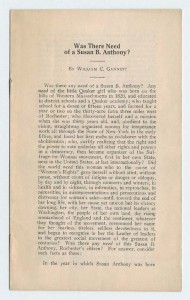 Gannett was the pastor of the church attended by Susan B. Anthony, and he firmly supported her in her many efforts to further the cause of women’s rights. He was especially helpful in the struggle to admit women as students to the University of Rochester. The President of the Board of Trustees of the University had told Anthony as early as 1891 that women’s enrollment in the University was not practical because of a lack of funds. In 1892, Gannett predicted in a meeting of the Chamber of Commerce that co-education would come to Rochester within ten years. In 1898, the University’s Board of Trustees agreed that if supporters of women’s entrance to the University could raise $100,000 within a year, women would be admitted. In 1899, sensing that popular opinion favored women’s admission and knowing that the sum of $100,000 was proving impossible to raise, the University lowered the amount to $50,000 and allowed another year to raise it. One day before the deadline, Anthony found that the fund was a heartbreaking $8,000 short. She worked tirelessly for the next hours before the fundraising deadline to raise the added funds. At her urging, Gannett stepped in and gave a large portion of the final amount of money necessary to secure the admission
Gannett was the pastor of the church attended by Susan B. Anthony, and he firmly supported her in her many efforts to further the cause of women’s rights. He was especially helpful in the struggle to admit women as students to the University of Rochester. The President of the Board of Trustees of the University had told Anthony as early as 1891 that women’s enrollment in the University was not practical because of a lack of funds. In 1892, Gannett predicted in a meeting of the Chamber of Commerce that co-education would come to Rochester within ten years. In 1898, the University’s Board of Trustees agreed that if supporters of women’s entrance to the University could raise $100,000 within a year, women would be admitted. In 1899, sensing that popular opinion favored women’s admission and knowing that the sum of $100,000 was proving impossible to raise, the University lowered the amount to $50,000 and allowed another year to raise it. One day before the deadline, Anthony found that the fund was a heartbreaking $8,000 short. She worked tirelessly for the next hours before the fundraising deadline to raise the added funds. At her urging, Gannett stepped in and gave a large portion of the final amount of money necessary to secure the admission 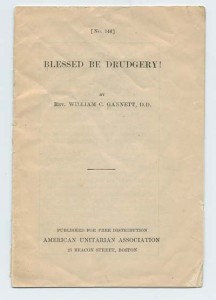 of women.
of women.
Gannett’s activities decreased during his years in Rochester, while those of his wife increased. This might have been in part due to the fact that Gannett suffered from progressive deafness, a malady that had been steadily worsening since his European trip in the mid-1860s. He was, however, known as a prolific writer. He wrote Sunday School lessons and hymns, and contributed to Unitarian journals and poetry books. He was one of the editors of Unity Hymns and Chorals, first published in 1880 and revised and enlarged in 1911. He published Of Making One’s Self Beautiful (1899) and A Wicket Gate to the Bible (1907). In 1896 Frank Lloyd Wright designed a book entitled The House Beautiful around an essay that Gannett had written.
In 1908, Gannett retired from active duty as pastor of Rochester’s Unitarian Church and assumed the title pastor emeritus. He died on December 15, 1923.
Bibliography of Suggested Books & Articles
- Barry, Kathleen, Susan B. Anthony: A Biography of a Singular Feminist, NY: NYU Press, 1988.
- Gannett, William C., Frank Lloyd Wright, John Arthur, The House Beautiful, Rohnert Park, Calif., Pomegranate, 1996 (This is a slightly modified reprint of an 1896 edition of 90 printed on a handpress by Wright and Winslow, designed around an essay by Gannett.
- Gannett, William C., The Story of Our Church, [St. Paul, Minn.]: Unity Church, 1991 (Reprint), 1879.
- Harper, Ida H., Life and Work of Susan B. Anthony, v. III (for information on Gannett’s role in women’s admission to the U of R.)
- Hobart, Alfred Walters, William Channing Gannett, Chicago: 1971 (microtext), 1928 (typescript).
- McKelvey, Blake, Rochester: The Quest for Quality, 1890-1925, Cambridge, Mass.: Harvard University Press, 1956.
- “Mrs. Gannett Mourned as Useful, Loved Citizen,” Rochester, NY, Democrat and Chronicle, October 25, 1952.
- Morse, John Torrey, Letters to William C. Gannett, 1920, 1923, Ms., Massachusetts Historical Society.
- Pease, William Henry, Doctrine and Fellowship: William Channing Gannett and the Unitarian Creedal Issue, NP, 1956 (Reprinted from Vol. XXV, no. 3, September 1956, Church History).
- Pease, William H., “The Gannetts of Rochester: Highlights of a Liberal Career, 1889-1923,” Rochester History, vol. XVII, No. 4 (Oct. 1955).
- Pease, William Henry, William Channing Gannett, a Social Biography, Ph.D. Thesis, University of Rochester, Dept. of History, 1955. (Microfilm, Rochester, NY: University of Rochester, 1973.)
- Stephenson, Harold William, Unitarian Hymn-writers, London: Lindsey Press, 1931. (copy available at Colgate Rochester Divinity School)
- The Religion of the Future, and other essays, London: British and Foreign Unitarian Association, 1909 (contains an essay by Gannett entitled “Religious liberalism”)
- Who Was Who in America: A Companion Volume to Who’s Who in America, vol. I, 1897-1942, Chicago: Marquis, 1942.
- The University of Rochester, Rush Rhees Library, Rare Books and Manuscripts has collections with information on the Gannetts.
Bibliography of Suggested Web Sites